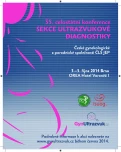Myo-inositol in the treatment of polycystic ovary syndrome
Authors:
P. Křepelka
Authors‘ workplace:
Katedra gynekologie a porodnictví 3. LF UK, Praha
; Katedra gynekologie a porodnictví IPVZ, Praha
; Ústav pro péči o matku a dítě, Praha, přednosta doc. MUDr. J. Feyereisl, CSc.
Published in:
Ceska Gynekol 2014; 79(3): 242-246
Overview
Objective:
Presentation of a comprehensive body of knowledge on the role of insulin sensitizer myo-inositol in the treatment of polycystic ovary syndrome (PCOS).
Design:
Review article.
Setting:
Institute for the Care of Mother and Child, Prague.
Method:
An overview of publishing data.
Results and conclusion:
Polycystic ovary syndrome is the most common cause of ovarian dysfunction and anovulatory infertility in women. The insulin resistance occurs very frequently as a part of PCOS. This paper reviews the literature documenting the effectiveness of insulin sensitizer myo-inositol in the treatment of ovarian dysfunction, symptoms of hyperandrogenism and wide complex of symptoms of metabolic syndrome. Six randomized controlled trials provides evidence of a positive effect of myo-inositol to normalize ovarian function, improve laboratory and clinical manifestations of hyperandrogenism and insulin resistance. The myo-inositol treatment has been demonstrated as a safe method of PCOS management.
Keywords:
polycystic ovary syndrome, insulin resistance syndrome, insulin sensitizers, myoinositol, metformin
Sources
1. Azziz, R., Carmina, E., Dewailly, D., et al. Task Force on the Phenotype of the Polycystic Ovary Syndrome of The Androgen Excess and PCOS Society. The Androgen Excess and PCOS Society criteria for the polycystic ovary syndrome: the complete task force report. Fertil Steril, 2009, 91(2), p. 456–488.
2. Carlomagno, G. Inositol Safety. Eur Rev Med Pharmacol Sci, 2011, 15(8), p. 931–936.
3. Ciampelli, M., Fulghesu, AM., Cucinelli, F., et al. Impact of insulin and body mass index on metabolic and endocrine variables in polycystic ovary syndrome. Metab Clin Exp 1999, 48, p. 167–172.
4. Constantino, D., Minozzi, G., Minozzi, E., et al. Metabolic and hormonal effects of myo-inositol in women with polycystic ovary syndrome: a double-blind trial. Eur Rev Med Pharmacol Sci, 2009, 13, p. 105–110.
5. Deeks, AA., Gibson-Helm, ME., Teede, HJ. Anxiety and depression in polycystic ovary syndrome: a comprehensive investigation. Fertil Steril, 2010, 93, p. 2421–2423.
6. Dunaif, A., Wu, X., Lee, A., et al. Defects in insulin receptor signaling in vivo in the polycystic ovary syndrome (PCOS). Am J Physiol Endocrinol Metab, 2001, 281(2), p. E392–E399.
7. Ehrmann, DA., Barnes, RB., Rosenfield, RL., et al. Prevalence of impaired glucose tolerance and diabetes in women with polycystic ovary syndrome. Diabetes Care, 1999, 22, p. 141–146.
8. Fait, T. Myo-inositol – nová možnost v ovlivnění infertility a syndromu polycystických ovarií. Prakt Gyn, 2013, 17(2), p. 129–134.
9. Fauser, BC., Tarlatzis, BC., Rebar, RW., et al. (the Amsterdam ESHRE/ASRM – Sponsored 3rd PCOS Consensus Workshop Group). Consensus on women´s health aspects of polycystic ovary syndrome. Fertil Steril, 2012, 97(1), p. 28–38.
10. Genazzani, AD., Lanzoni, C., Ricchieri, F., et al. Myo-inositol administration positively affects hyperinsulinemia and hormonal parameters in overweight patients with polycystic ovary syndrome. Gynecol Endocrinol, 2008, 24, p. 139–144.
11. Gerli, S., Mignosa, M., Di Renzo, GC. Effects of inositol on ovarian function and metabolic factors in women with PCOS: a randomized double blind placebo-controlled trial. Eur Rev Med Pharmacol Sci, 2003, 7, p. 151–159.
12. Gerli, S., Papaleo, E., Ferrari, A., et al. Randomized, double blind placebo-controled trial: effects of myoinositol on ovarian function and metabolic factors in women with PCOS. Eur Rev Med Pharmacol Sci, 2007, 11, p. 347–354.
13. Homburg, R. Polycystic ovary syndrome – from gynaecological curiosity to multisystem endocrinopathy. Hum Reprod, 1996, 11, p. 29–39.
14. Larner, J. D-chiro-inositol – its functional role in insulin action and its deficit in insulin resistence. Int J Exp Diabetes Res, 2002, 3, p. 47–60.
15. Legro, RS., Barnhart, HX., Schlaff, WD. Clomifene, metformin or both for infertility in the PCOS. N Engl J Med, 2007, 356(6), p. 551–566.
16. March, WA., Moore, VM., Willson, KJ., et al. The prevalence of polycystic ovary syndrome in a community sample assessed under contrasting diagnostic criteria. Hum Reprod, 2010, 25, p. 544–551.
17. Minozzi, M., D´Andrea, G., Unfer, V. Treatment of hirsutism with myo-inositol: a prospective clinical study. Reprod Biomed Online, 2008, 17, p. 579–582.
18. Nestler, JE., Jakubowicz, DJ., Reamer, P., et al. Ovulatory and metabolic effects of D-chiro-inositol in the polycystic ovary syndrome. N Engl J Med, 1999, 340, p. 1314–1320.
19. Otta, CF., Wior, M., Iraci, GS., et al. Clinical, metabolic, and endocrine parameters in response to metformin and lifestyle intervention in women with polycystic ovary syndrome: a randomized, double-blind, and placebo control trial. Gynecol Endocrinol, 2010, 26(3), p. 173–178.
20. Papaleo, E., Unfer, V., Baillargeon, JP., et al. Myo-inositol in patients with polycystic ovary syndrome: a novel method for ovulation induction. Gynecol Endocrinol, 2007, 23, p. 700–703.
21. Papaleo, E., Unfer, V., Baillargeon, JP., et al. Myo-inositol may improve oocyte quality in intracytoplasmic sperm injection cycle. A prospective, controlled, randomized trial. Fertil Steril, 2009, 91, p. 1750–1754.
22. Raffone, E., Rizzo, P., Benedetto, V. Insulin sensitiser agent alone and in co-treatment with r-FSH for ovulation induction in PCOS women. Gynecol Endocrinol, 2010, 26, p. 275–280.
23. Toulis, KA., Goulis, DG., Farmakiotis, D., et al. Adiponectin levels in women with polycystic ovary syndrome: a systematic review and a meta-analysis. Hum Reprod Update, 2009, 15(3), p. 297–307.
24. Unfer, V., Carlomagno, G., Dante, G., et al. Effects of myo-inositol in women with PCOS: a systematic review of randomized controlled trials. Gynecol Endocrinol, 2012, 28(7), p. 509–515.
Labels
Paediatric gynaecology Gynaecology and obstetrics Reproduction medicineArticle was published in
Czech Gynaecology

2014 Issue 3
Most read in this issue
- Diagnostic algorithm in pregnancies of uncertain viability or unknown location – a review of the latest recommendations
- Myo-inositol in the treatment of polycystic ovary syndrome
-
Prenatal diagnosis of skeletal dysplasia in first trimester of pregnancy
X-linked dominant chondrodysplasia punctata - HELLP syndrome complicated by liver rupture – case report
